Evaluation of Soil Characteristics for Agricultural Machinery Management and Cropping Requirements in AL Aflaj Oasis, Saudi Arabia
Abstract
:1. Introduction
1.1. Novelty of the Intended Study Soil
1.2. Historical Soil Surveys
2. Materials and Methods
2.1. Description of the Study Area
2.2. Soil Profile and Analysis of the Study Samples
- (1)
- In a 2 mm thickness sieve, the soil samples were riddled; a portion greater than 2 mm was separated, and the percentage of gravel was estimated based on the total sample mass.
- (2)
- Soil texture was determined for each layer of the soil profile as follows:
- (a)
- Soluble salts and calcium carbonate were removed using 0.1 mol L−1 of HCl and washed with distilled water.
- (b)
- Organic material was removed using 30% hydrogen peroxide (H2O2), followed by washing with distilled water.
- (c)
- Mechanical analysis of the soil samples was implemented using the pipette method on sieved (under 2 mm, non-rough soil) soil samples.
- (d)
- The soil sample was scattered by using sodium hexametaphosphate ((NaPO3)6), and then the percentage of silt, clay, and sand were calculated.
- (3)
- Total calcium carbonate (total CaCO3) was calculated in representative samples using calcimetric analysis through the measurement of the equivalent CO2 volume produced by the interaction of the calcium carbonate (CaCO3) of the soil sample with hydrochloric acid (HCl). The results were used to estimate the amount of calcium carbonate (CaCO3, gkg−1), which was subsequently estimated as a percentage of total mass (%).
- (4)
- Electrical conductivity (ECe) was measured using an EC-meter (dsm−1), and pH was measured using a pH-meter in the extracted saturated soil paste. The soil saturation ratio (SP) was then measured.
- (5)
- The organic matter content was estimated by digesting the soil sample in concentrated sulfuric acid with a known amount of potassium bichromate (also called potassium dichromate, K2Cr2O7) and a diphenylamine indicator. An increase in potassium bichromate was measured by the standard calibration of ferrous sulfate (iron sulfate) and 0.01 M ammonium. The organic matter content (gkg−1) of the soil was calculated and subsequently estimated as a percentage (%).
2.3. Statistical Analysis
3. Results
3.1. Morphological Description of the Soil Surface Phenomena
3.2. Results of Physical and Chemical Analysis of Soil Samples
3.2.1. Soil Texture
3.2.2. Calcium Carbonate (CaCO3)
3.2.3. Organic Material
3.2.4. Soil Salinity (ECe) and Percentage of Saturation (SP)
3.2.5. Soil Acidity and Alkalinity (pH)
3.3. General Formation and Classification of the Studied Soil
4. Discussion
- (1)
- The results of this study showed that the predominant texture of the farm soil varied between sandy and sandy loam textures, and a coarse texture (rough properties) was exhibited throughout the entire profile. The contribution percentages of the physical properties of the soil horizons to the total soil texture are indicated in Figure 5. The primary recommendation is to closely follow the service operations for this type of soil, which requires the efficient use of irrigation water, soil fertilizers, and soil amendments. The most important field service operation is the use of a closely monitored modern irrigation system (sprinkler or drip system) and evenly distributing the irrigation periods as much as possible to prevent the loss of added water through seepage into the lower levels. In addition, periodic washing of soil by adding excess water beyond the levels of normal agricultural irrigation, especially with the surface irrigation system, will prevent future fertility limitations and other effects of excess salt build-up in the topsoil horizon resulting from the elevated salinity of the agricultural irrigation water.
- (2)
- Improving the levels of soil nutrient elements requires a more detailed description and analysis of the farm soil to determine the levels of the major nutrient elements (N, P, and K) and other minor elements (micronutrients such as Fe, Zn, Cu, and Mn). Thus, a soil nutrient improvement program should include an ongoing integrated analysis and management program to monitor and raise nutrient element levels in field soil. This will avoid the disadvantages and damage resulting from decreasing nutrient levels inherent in coarse sandy or limy (Calcic) soils.
- (3)
- Based on the laboratory analysis, there were statistically significant differences between the soil horizons in their chemical properties. Figure 6 shows the extent to which the chemical properties of the farm soil horizons contribute to the total soil characteristics. However, the chemical and nutritional properties of the soil can be improved through the regular addition of an appropriate quantity and quality of natural organic or manufactured fertilizers, as well as the use of efficient plant and agricultural crop residues with good decomposition rates to increase the soil’s biological activities. These measures increase the ability of various crops to extend their roots into the soil, so soil improvements will persist in the long term. Modern agricultural machines, such as those commonly used for cutting, crushing, separating, grinding, and fragmentation of plant residues, especially residues of palm trees after periodic pruning processes, should be extensively used to minimize the particle size of these residues. Reduced particle size would contribute to quick decomposition of the residues and their integration into the field soil to increase soil fertility and biological activity. As these residues are mixed into the soil, plowing has valuable benefits for improving the soil organic matter content and pH. In addition, the application of sustainability in agriculture using chemical fertilizers could be applied to support the revitalization of poor soil fertility and the enrichment of the range of nutrients available to plants. The application of chemical fertilizers in such arid soils greatly enhances the nutritional health of field plants and thus increases the productivity of crops and fruit (i.e., food production) [25].
- (4)
- Soil influenced by saline springs may not contribute to emanating plant buds from the soil or to raising the percentage of crop germination, or it may turn into saline soil with a hard surface layer. Improving water management, crop growth, and production in any type of soil can be achieved by predicting the optimal infiltration of irrigation water. Therefore, the use of modern irrigation systems, particularly surface and subsurface drip irrigation systems, along with establishing subsurface drainage channels, would significantly reduce the content of salts and gypsiferous sediments (gypsum) in the soil, resulting in the compression of soil horizons. Furthermore, due to the lack of nutrient elements in the soil, adding chemical materials to the irrigation water is required to increase nutrient levels and overcome the increases in pH and salts. Another recommendation related to water salinity removal includes the use of modern methods and technologies to remove salts from irrigation water, such as magnetic system procedures for cracking and salt detachment.
- (5)
- An additional recommendation includes the regular execution of periodic harrowing and tillage of the soil, especially sub-surface plowing using a plow under the soil surface (e.g., chisel and furrow plows, deep cultivator digger), to break up the subsurface solid layer at 100 cm. This will also reduce the consolidation of soil, allow the field crops to extend their roots more easily and evenly into the lower soil horizons, and improve the overall physical properties of the farm soil. Other scientific studies in fields that have soils similar to the sandy loam soil of the studied farm showed that the use of deep cultivator diggers (chisel plows) in a field of blended soil that had a combination texture of silt, clay, and loam soil (silty clay loam soil) achieved better performance and lower total operating costs when compared to other plowing machines, such as disc and moldboard plows [26]. The plow under the soil surface (deep cultivator digger) also provides the best performance in breaking down solidity in the subsurface soil, with an increase in the soil porosity suitable for the extension of crop roots [27]. Additionally, in sandy clay loam soil, tractor performance improves with the lowest percentage of wheel tractor slip when operated with the deep cultivator digger (chisel plow), which exhibits the least resistance to soil penetration under an appropriate plowing depth and soil moisture conditions [28]. To improve some of the physical properties of the soil, Ali et al. [29] recommended the use of a moldboard plow when dealing with soils of sedimentary origin. The moldboard plow operation afforded good performance in providing a suitable hotbed (seedbed) for crop growth, the highest productivity of field crops (e.g., alfalfa, sorghum, and maize), better soil moisture, and smaller soil aggregate size (prevention of the massive structures of plowed soil).
- (6)
- It is important to conduct a more detailed study of the subject farm to build a varied crop structure that is suitable for the properties of the soil of this farm while considering the farm irrigation water quantity and quality. In general, the major determinants of this study area were the high calcium carbonate rate, coarse texture, and high gravel ratio; however, the study area was considered appropriate for agricultural activity. Therefore, studying and analyzing soil properties for land reclamation and the restoration of vegetation by providing more effective soil in areas that have been submerged in water for many years is particularly important for optimum agricultural investments. Therefore, it is recommended that more attention is given to lands that are high in calcium carbonate, poor in organic matter, and have been significantly affected by spring surface water flow for a long period of time.
- (7)
- In summary, the primary findings of the intended land capability evaluation were that soil levels have the potential to provide sufficient information to clarify the effect of ancient water springs on soil texture, stages of vegetative growth and production of plants, and cultivation systems in the Al Aflaj area. However, it is important to perform more detailed studies of the surrounding farmlands and the effects of Al Aflaj springs (pools of water) and their Khariz (Qanats—ancient subsurface irrigation canals)—on the soil structure and types, its properties, and future agriculture activities in the area. There is a high probability that this region of agricultural farmlands had been submerged in the water of the Al Aflaj Oasis springs in the ancient past, and the area of Qussayrat Ad, which is located in the east, is the best evidence to prove the existence of an ancient agricultural civilization around the study area.
5. Conclusions
Funding
Institutional Review Board Statement
Informed Consent Statement
Data Availability Statement
Acknowledgments
Conflicts of Interest
References
- Ministry of Environment, Water & Agriculture. Agriculture Statistical Year Book; No. 27; Agricultural Research and Development Affairs (Formerly), Department of Economic Studies and Statistics: Riyadh, Saudi Arabia, 2014. (In Arabic)
- Ministry of Environment, Water & Agriculture. Agriculture Statistical Year Book-2018; Deputy-Ministry for Economic Affairs and Investment, General Administration of Information and Statistics: Riyadh, Saudi Arabia, 2019; p. 209. Available online: https://www.mewa.gov.sa/ar/InformationCenter/Researchs/Reports/GeneralReports/%D8%A7%D9%84%D9%83%D8%AA%D8%A7%D8%A8%20%D8%A7%D9%84%D8%A5%D8%AD%D8%B5%D8%A7%D8%A6%D9%8A%201439-1440%D9%87%D9%80%20sp%202.pdf (accessed on 9 September 2020). (In Arabic)
- Al-Mashhady, A.S.; Sheta, A.S.; Sallam, A.S. Soil Types and Agricultural Management Methods in the Kingdom of Saudi Arabia; Agricultural extension bulletin number 68; Agricultural Extension Center, College of Food and Agricultural Sciences, King Saud University: Riyadh, Saudi Arabia, 1998. (In Arabic) [Google Scholar]
- Ministry of Environment, Water & Agriculture. General Soil Map of the Kingdom of Saudi Arabia (Soil Atlas); Department of Lands Investment Management (Formerly): Riyadh, Saudi Arabia, 1986. (In Arabic)
- Ministry of Environment, Water & Agriculture. Atlas of Land Resource; Department of Lands Investment Management (Formerly): Riyadh, Saudi Arabia, 1995. (In Arabic)
- Sheta, A.S. Soil Quality: Standards of Soil Quality under the Conditions of Saudi Arabia, 7th ed.; Saudi Society for Agricultural Sciences, King Saud University: Riyadh, Saudi Arabia, 2004. (In Arabic) [Google Scholar]
- Al-Barrak, S.A. Characteristics and classification of some coastal soils of Al-Ahsa, Saudi Arabia. J. King Saud Univ. Agric. Sci. 1997, 9, 319–333. Available online: http://ksupress.ksu.edu.sa/Ar/Lists/JournalAricle/Attachments/2456/V9M115R2875.pdf (accessed on 9 May 2020).
- Youssef, A.F. Soil distribution pattern and gypsic soils of Alqatif Oasis, Saudi Arabia. J. King Saud Univ. Agric. Sci. 1991, 3, 127–138. Available online: http://ksupress.ksu.edu.sa/Ar/Lists/JournalAricle/Attachments/1342/V3M198R1514.pdf (accessed on 9 May 2020).
- Al-Mashhady, A.S.; Reda, M.; Hammad, M.A. Soil association of Al-Qassim region, Saudi Arabia. J. King Saud Univ. Agric. Sci. 1991, 3, 149–165. Available online: http://ksupress.ksu.edu.sa/Ar/Lists/JournalAricle/Attachments/1340/V3M198R1512.pdf (accessed on 9 May 2020).
- Youssef, A.F. Bediology: Soil Origin, Morphology, and Classification; Deanship of Library Affairs, King Saud University: Riyadh, Saudi Arabia, 1987. (In Arabic) [Google Scholar]
- Al-Barrak, S.A. Characterization and classification of some soils in Al-Sawdah, southwestern Saudi Arabia. J. King Saud Univ. Agric. Sci. 1985, 7, 269–283. Available online: http://cfas.ksu.edu.sa/en/content/soil-pedology-and-mineralogy (accessed on 9 May 2020).
- Sheta, A.S.; Al-Sewailem, M.S.; Sallam, A.S.; Al-Amry, A.M. Pedological characteristics of the soils of Wadi Bishah in southwestern region, Saudi Arabia. J. King Saud Univ. Agric. Sci. 2004, 17, 47–62. Available online: https://www.researchgate.net/publication/281678074 (accessed on 9 May 2020).
- Al-Nashwan, A.A. Al Aflaj Area, a Field Geographical Study; Al-Rushed Library: Riyadh, Saudi Arabia, 1990. (In Arabic) [Google Scholar]
- Philby, H.S.J.B. Two notes from Central Arabia: The pools of Aflaj. Geogr. J. 1949, 113, 86–93. [Google Scholar] [CrossRef]
- Ministry of Environment, Water & Agriculture. Statistics of Agricultural Census By Kingdom’s Agricultural Directorates 1999; Agricultural Research and Development Affairs (Formerly), Department of Economic Studies and Statistics: Riyadh, Saudi Arabia, 2001. (In Arabic)
- Ministry of Finance and National Economy. Geological Map of the Southern Ferrule Plate in Saudi Arabia: Map No. 212A-I; Directorate General of Oil and Minerals, Ministry of Finance and National Economy, US Geological Survey, Ministry of Interior (Formerly): Riyadh, Saudi Arabia, 1956. (In Arabic)
- USGS-United States Geological Survey. Geology of the Southern Tuwayq Quadrangle, the Kingdom of Saudi Arabia, Map: I-212 A, 1956, USA. 2012. Available online: https://pubs.usgs.gov/imap/0212a/plate-1.pdf (accessed on 12 May 2020).
- SAS Institute Inc. SAS User’s Guide Statistics: SAS® 9.4 Graph Template Language, 5th ed.; SAS Institute Inc.: Cary, NC, USA, 2016; Available online: https://documentation.sas.com/api/docsets/grstatug/9.4/content/grstatug.pdf?locale=en (accessed on 15 September 2020).
- FAO-Food and Agriculture Organization of the United Nations. Salt-Affected Soils and their Management: Water Quality and Crop Production; FAO Soils Bulletin 39 (M-53); Food and Agriculture Organization of the United Nations: Rome, Italy, 1988; ISBN 92-5-102686-6. Available online: http://www.fao.org/3/x5871e/x5871e07.htm (accessed on 9 September 2020).
- Merdy, P.; Gamrani, M.; Montes, C.R.; Rezende Filho, A.T.; Barbiero, L.; Ishida, D.A.; Silva, A.R.C.; Melfi, A.J.; Lucas, Y. Processes and rates of formation defined by modelling in alkaline to acidic soil systems in Brazilian Pantanal wetland. Catena 2021, 210, 105876. [Google Scholar] [CrossRef]
- USDA-United States Department of Agriculture. Soil Taxonomy: A Basic System of Soil Classification for Making and Interpreting Soil Surveys. Agriculture Handbook, 2nd ed.; No. 436; United States Department of Agriculture, Natural Resources Conservation Service: Washington, DC, USA, 1999. Available online: https://www.nrcs.usda.gov/Internet/FSE_DOCUMENTS/nrcs142p2_051232.pdf (accessed on 12 May 2020).
- FAO-Food and Agriculture Organization of the United Nations. World Reference Base for Soil Resources 2014: International Soil Classification System for Naming Soils and Creating Legends for Soil Maps; World Soil Resources Reports No. 106; 2015; ISBN 978-92-5-108369-7. Available online: http://www.fao.org/3/i3794en/I3794en.pdf (accessed on 9 September 2020).
- Sposito, G. Soil: FAO Soil Groups; Encyclopaedia Britannica Inc.: Chicago, IL, USA, 2020; Available online: https://www.britannica.com/science/soil/FAO-soil-groups (accessed on 9 September 2020).
- Shirzaei, M.; Khoshmanesh, M.; Ojha, C.; Werth, S.; Kerner, H.; Carlson, G.; Sherpa, S.F.; Zhai, G.; Lee, J.C. Persistent impact of spring floods on crop loss in U.S. Midwest. Weather. Clim. Extrem. 2021, 34, 100392. [Google Scholar] [CrossRef]
- Al-Dosary, N.M.N.; Abdel-Sattar, M.; Aboukarima, A.M. Effect of Ammonium Sulphate Incorporated with Calcium Nitrate Fertilizers on Nutritional Status, Fruit Set and Yield of Pomegranate Trees cv. Wonderful. Agronomy 2022, 12, 971. [Google Scholar] [CrossRef]
- Jasim, A.A.; Jebur, H.A. Impact of primary tillage system on fuel consumption, management, and total tractor costs. Baghdad Univ. Iraqi J. Agric. Sci. 2015, 46, 31–35. Available online: https://www.iasj.net/iasj?func=fulltext&aId=95609 (accessed on 6 January 2021). (In Arabic with English Abstract).
- Al-Khafaji, A.J. Effect of subsoiler plowing depth on the removing of hardpan and corn yield. Univ. Kufa Kufa J. Agric. Sci. 2009, 1, 21–29. Available online: https://www.iasj.net/iasj/download/6991da9b6943bbf2 (accessed on 6 January 2021). (In Arabic with English Abstract).
- Mamkagh, A.M.A. Some factors affecting the wheel slip of a 2WD farm tractor. Univ. Jordan Jordan J. Agric. Sci. 2009, 5, 519–525. Available online: https://journals.ju.edu.jo/JJAS/article/view/866-1744-1-SM (accessed on 6 January 2021). (In Arabic with English Abstract).
- Ali, K.M.; Tahir, M.A.; Abd Alamer, H.K. Influence of plowing system on zea maize production and some soil characteristics. AL-Taqani Iraqi Found. Tech. Educ. 2011, 24, 260–268. Available online: https://www.iasj.net/iasj?func=fulltext&aId=29589 (accessed on 6 January 2021). (In Arabic with English abstract).
- Tyagi, S.; Naresh, R.K.; Bhatt, R.; Chandra, M.S.; Alrajhi, A.A.; Dewidar, A.Z.; Mattar, M.A. Tillage, Water and Nitrogen Management Strategies Influence the Water Footprint, Nutrient Use Efficiency, Productivity and Profitability of Rice in Typic Ustochrept Soil. Agronomy 2022, 12, 1186. [Google Scholar] [CrossRef]
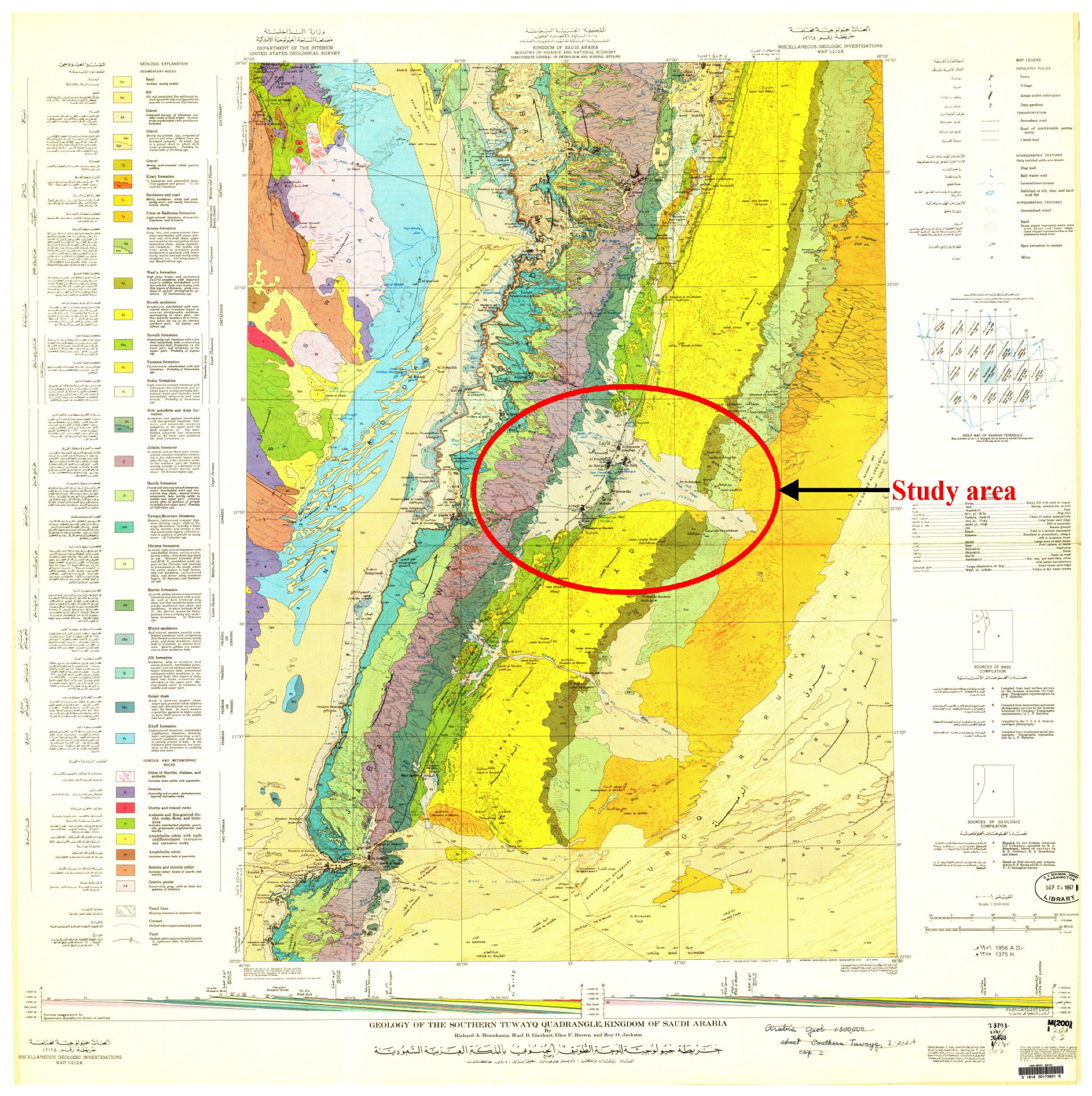
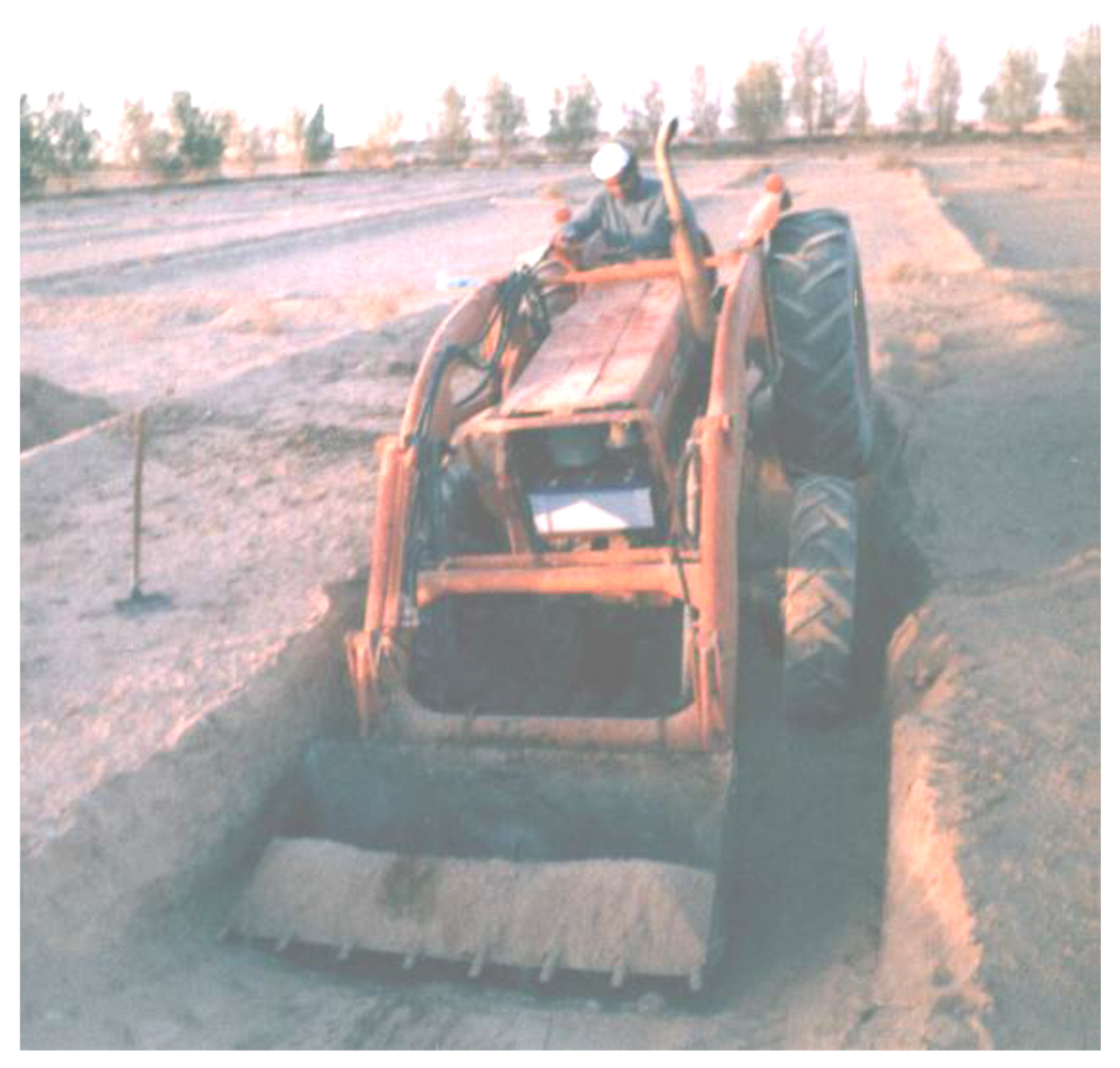
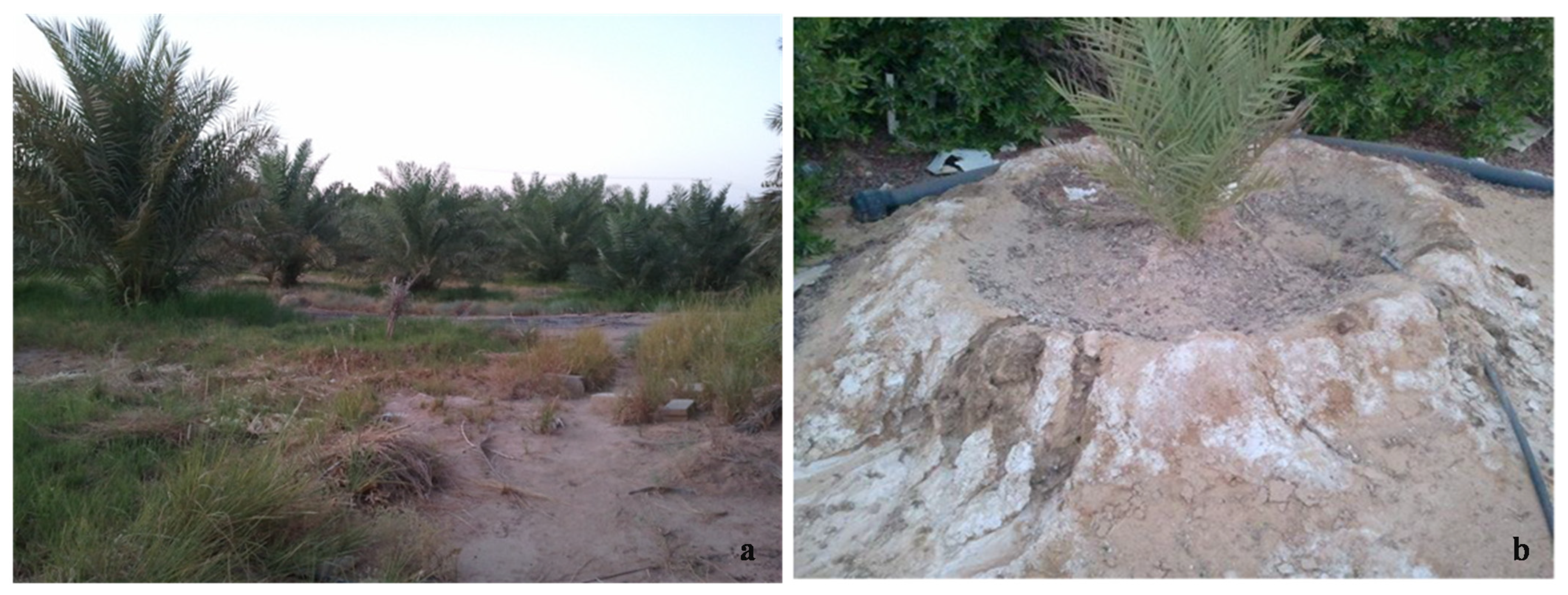
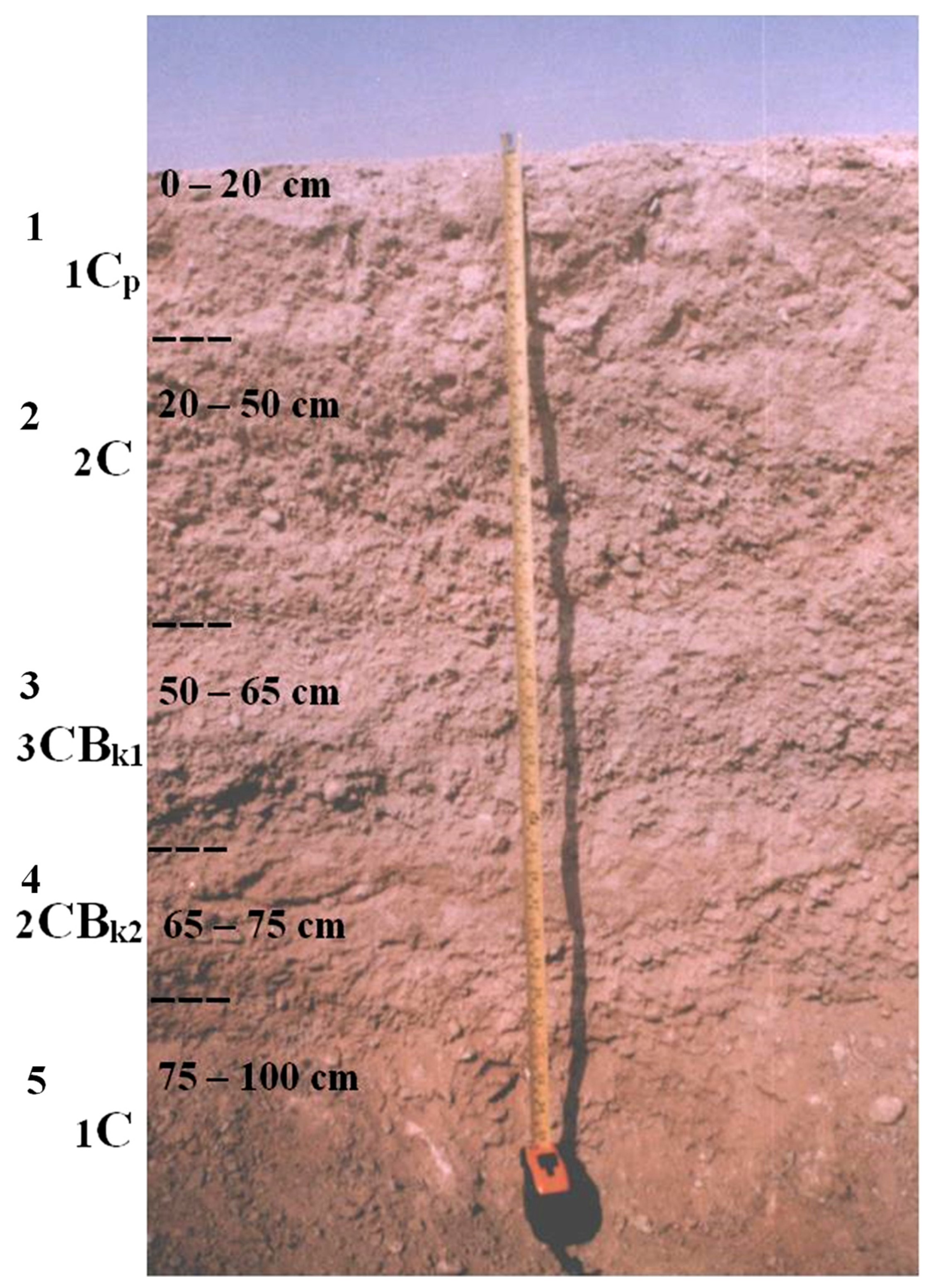
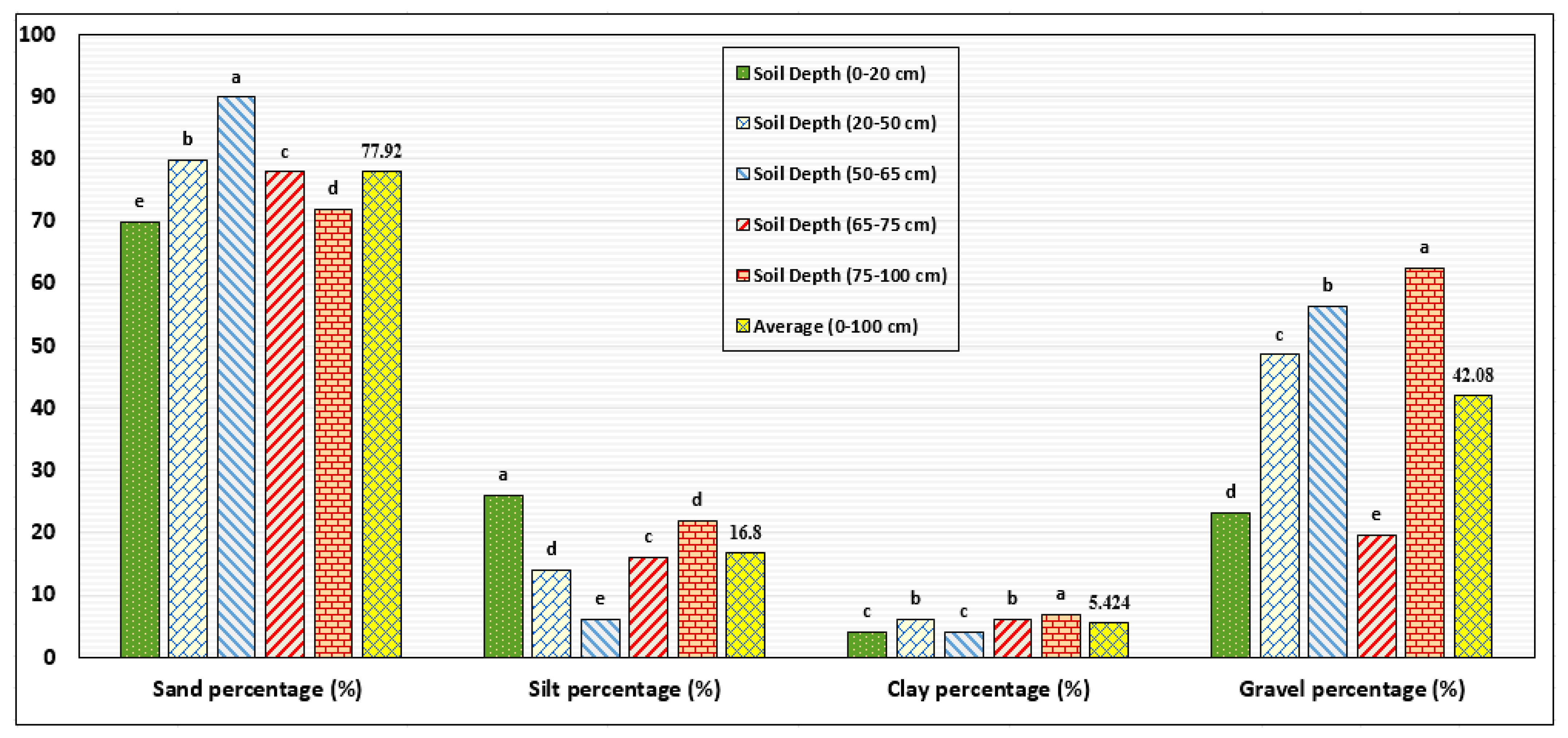
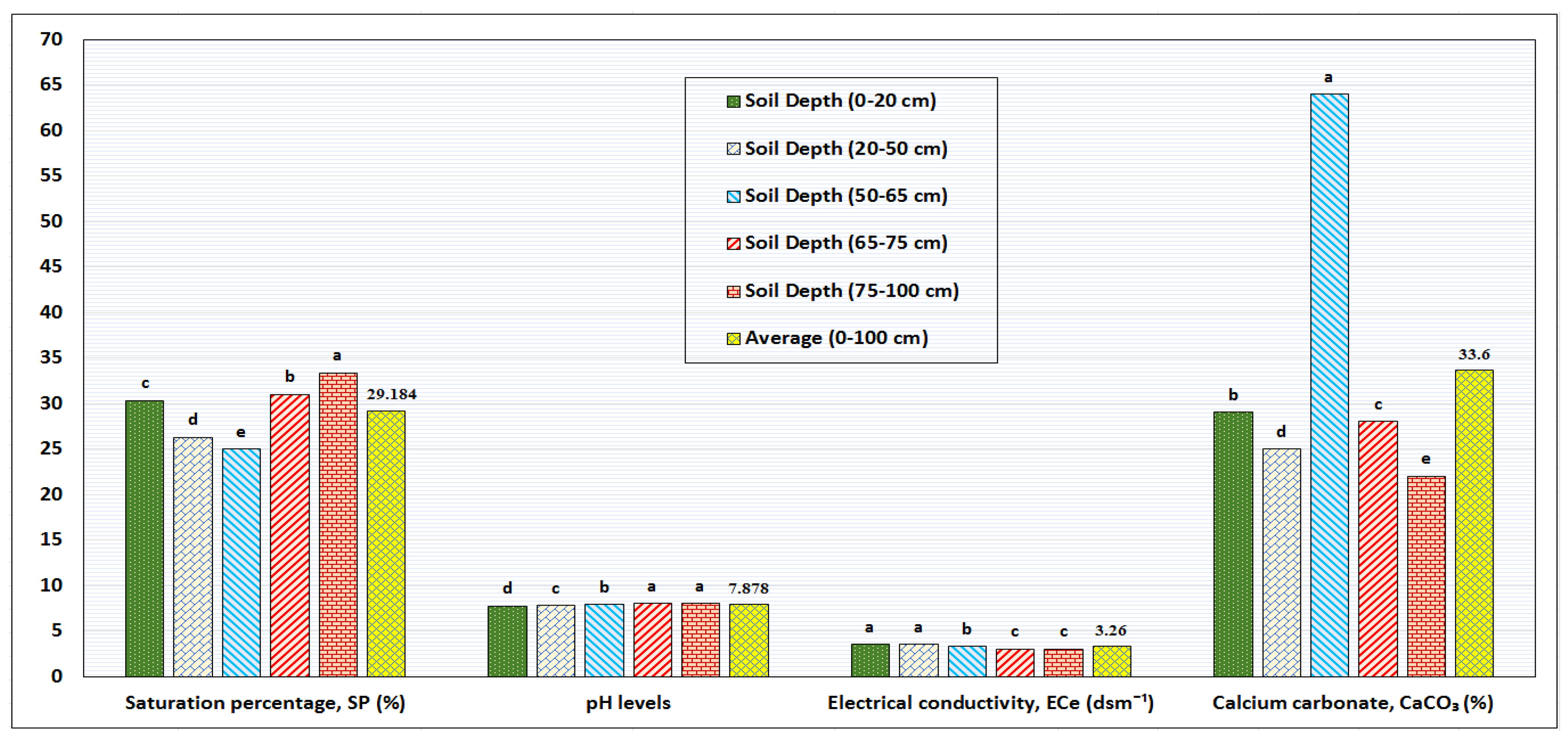
| Particle Size Distribution of the Granules Soil | ||||||
|---|---|---|---|---|---|---|
| No. of Soil Profile Horizon | Depth of Soil Profile (cm) | Sand Percentage (%) | Silt Percentage (%) | Clay Percentage (%) | Gravel Percentage (%) | Texture Class |
| 1 | 00–20 | 69.92 e | 26 a | 4.08 c | 23.20 d | Gravelly sandy loam |
| 2 | 20–50 | 79.92 b | 14 d | 6.08 b | 48.60 c | Gravelly loamy sand |
| 3 | 50–65 | 89.92 a | 6 e | 4.08 c | 56.40 b | Very gravelly sand |
| 4 | 65–75 | 77.92 c | 16 c | 6.08 b | 19.70 e | Gravelly loamy sand |
| 5 | 75–100 | 71.92 d | 22 b | 6.80 a | 62.50 a | Very gravelly sandy loam |
| Average | 00–100 | 77.92 a | 16.80 c | 5.424 d | 42.08 b | |
| No. of Soil Profile Horizon | Depth of Soil Profile (cm) | Saturation Percentage, SP (%) | Ph Levels | Electrical Conductivity, Ece (Dsm−1) | Calcium Carbonate, Caco3 (%) | Organic Material Percentage (%) |
|---|---|---|---|---|---|---|
| 1 | 00–20 | 30.33 c | 7.73 d | 3.50 a | 29 b | 0.22 b |
| 2 | 20–50 | 26.26 d | 7.79 c | 3.50 a | 25 d | 0.20 c |
| 3 | 50–65 | 25.00 e | 7.93 b | 3.30 b | 64 a | 0.03 d |
| 4 | 65–75 | 31.00 b | 7.97 a | 3.00 c | 28 c | 0.03 d |
| 5 | 75–100 | 33.33 a | 7.97 a | 3.00 c | 22 e | 0.27 a |
| Average | 00–100 | 29.184 a | 7.878 b | 3.260 b | 33.600 a | 0.150 b |
| Depth of Soil Profile (cm) | Symbol of Each Soil Horizon | Description of Each Soil Profile Horizon |
|---|---|---|
| 00–20 | 1Cp | 10 YR 7/4 Pink (dry), 10 YR 5/6 Strong brown (moist). The soil has an accumulated and cohesive structure, slight hardness of structure with a percentage of gravel, adhesive, plastic, medium roots, and integrated wavy boundaries. |
| 20–50 | 2C | 7.5 YR 6/6 reddish yellow (dry), 7.5 YR 5/6 yellowish red (moist). A less cohesive mass structure, with a percentage of gravel, few roots, and integrated wavy boundaries. |
| 50–65 | 3CBk1 | 7.5 YR 6/6 reddish yellow (dry), 7.5 YR 5/6 yellowish red (moist). Soil with a less cohesive accumulated structure, with a percentage of gravel, integrated wavy boundaries, and soft accumulated limestone. |
| 65–75 | 2CBk2 | 7.5 YR 6/6 reddish yellow (dry), 7.5 YR 4/6 yellowish red (moist). The soil has a less cohesive accumulated structure, less soil structure with a percentage of gravel, adhesive, plastic, integrated wavy boundaries, and soft accumulated limestone. |
| 75–100 | 1C | 7.5 YR 6/6 reddish yellow (dry), 7.5 YR 5/6 yellowish red (moist). The soil has a cohesive mass structure with accumulated limestone, less solid structure with a proportion of gravel, a slightly adhesive structure, and wavy boundaries. |
| General classification of the soil profile | Typic Haplocalcids | |
Publisher’s Note: MDPI stays neutral with regard to jurisdictional claims in published maps and institutional affiliations. |
© 2022 by the author. Licensee MDPI, Basel, Switzerland. This article is an open access article distributed under the terms and conditions of the Creative Commons Attribution (CC BY) license (https://creativecommons.org/licenses/by/4.0/).
Share and Cite
Al-Dosary, N.M.N. Evaluation of Soil Characteristics for Agricultural Machinery Management and Cropping Requirements in AL Aflaj Oasis, Saudi Arabia. Sustainability 2022, 14, 7991. https://doi.org/10.3390/su14137991
Al-Dosary NMN. Evaluation of Soil Characteristics for Agricultural Machinery Management and Cropping Requirements in AL Aflaj Oasis, Saudi Arabia. Sustainability. 2022; 14(13):7991. https://doi.org/10.3390/su14137991
Chicago/Turabian StyleAl-Dosary, Naji Mordi Naji. 2022. "Evaluation of Soil Characteristics for Agricultural Machinery Management and Cropping Requirements in AL Aflaj Oasis, Saudi Arabia" Sustainability 14, no. 13: 7991. https://doi.org/10.3390/su14137991






